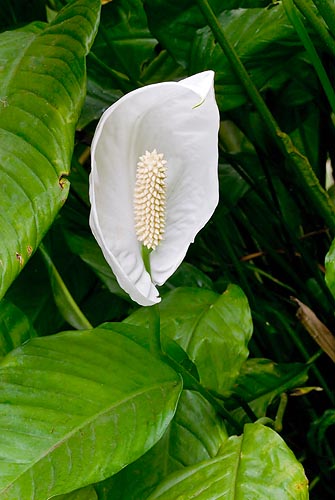Family : Araceae

Text © Pietro Puccio

English translation by Mario Beltramini

It is one of the most diffused indoor plants © Mazza
The name of the genus is the combination of the Greek words “spatha” = spathe, and “phyllon” = leaf, with reference to the spathe of the inflorescence, similar to a leaf; the species is honoured to the German botanist, explorer and collector, Gustav Wallis (1830-1878).
Common names: “peace lily”, “spathe flower”, “white flag”, “white sail”, (English); “fleur de lune”, “lis de la paix”, “spathiphylle de Wallis” (French); “spatifillo” (Italian); “lirio-da-paz” (Portuguese); “cuna de Moisés”, “bandera blanca”, “espatifilo”, “espatifilum” (Spanish); “Einblatt” (German).
Rhizomatous, herbaceous, evergreen plant, stem-less, cespitose, with oblong lanceolate, curved and glossy dark green leaves, rather coriaceous, and with undulated edges, 10-25 cm long and 5-10 broad, on petioles of the same or major length.
Long lasting inflorescence on an about 45 cm long peduncle, formed by a white, tending to the green with the time, spathe, hollow, with a sharp apex, 6-18 cm long and 4-8 cm broad, and by a cream-white 4-10 cm long spadix; the flowers, slightly perfumed, are protogynous (the stigma, the female part, is receptive before the ripening of stamens, thus avoiding self-fertilization), hermaphrodite; the fruits are green ovoid berries long about 4 mm. It reproduces by seed and division, industrially by micro-propagation.
Plant which can be cultivated in open air in the tropical and humid subtropical zones, in shaded positions, on very porous and organic substrata. Elsewhere, it is to be cultivated in pot, and as such, is one of the most spread indoor plants with its varieties and hybrids; it requires much ventilated substrata, draining and rich of organic substance and is to be placed in a location without draughts, luminous, but it bears also rather shady positions, avoiding even occasional and short expositions to the direct sun, which easily harms the leaves; it is good to maintain the temperatures over the 16°C, best around 20-24°C, without sudden variations.
Watering must be frequent, always avoiding water stagnations which can generate rottenness, the substratum must never dry up completely, and the ambient humidity is to be rather high, to be increased by means of nebulisations in case of dry air and high temperatures, utilizing water at room temperature and not calcareous, in order to avoid anti-aesthetic spots on the leaves. It adapts well also to hydroponics.
All the parts of the plant contain toxic substances, in particular calcium oxalate, which can cause contact dermatitis in particularly sensitive persons, and reactions, even serious, if chewed and ingested.
